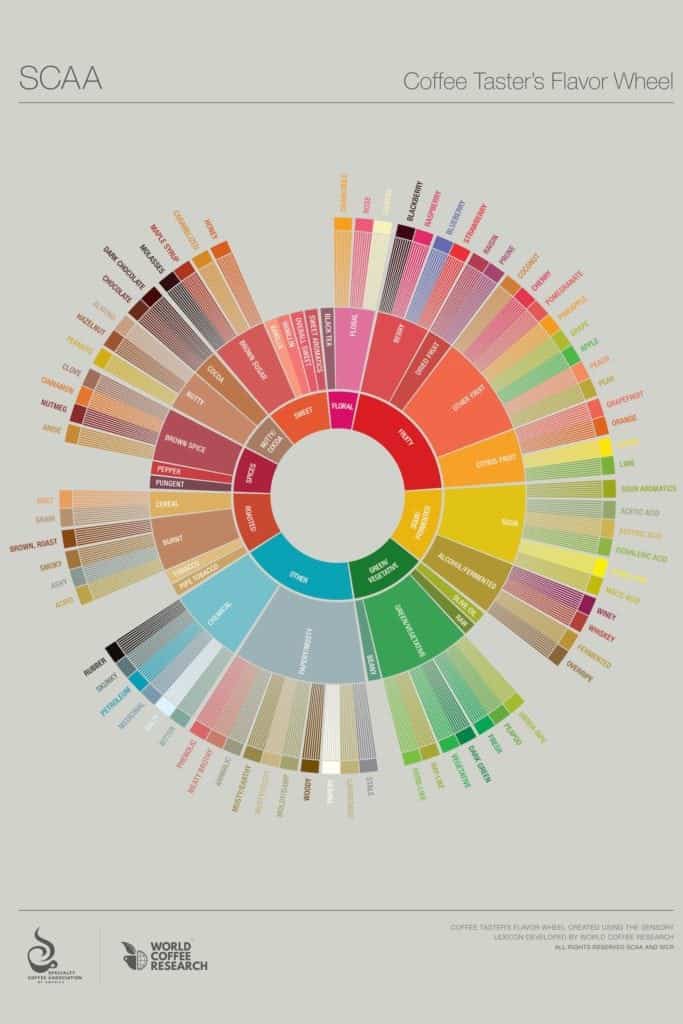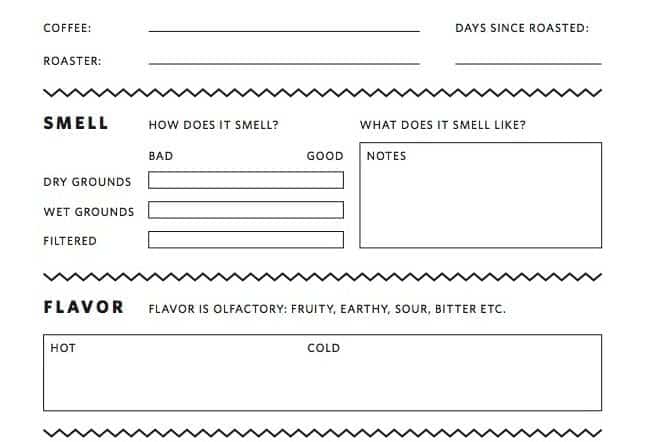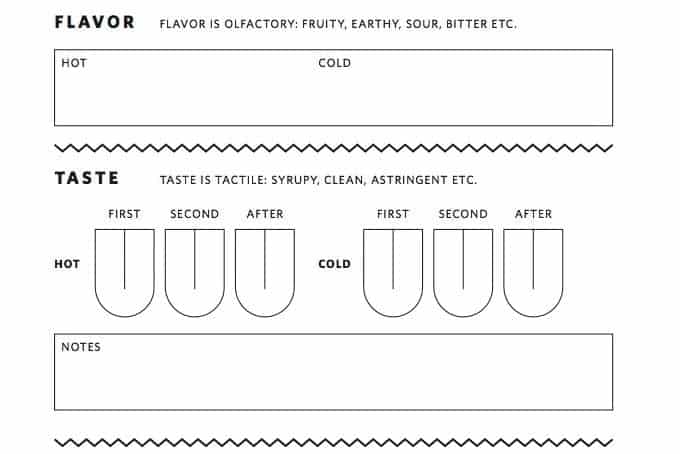We have attended many public cuppings and organised some ourselves, and we had to agree with Conrad Altmann who thought: “There must be an easier and more approachable way of scoring coffees together with customers!” Would speciality coffee gain wider attention from the public if the sheets were re-designed in such a way that was more helpful for those customers who taste the coffees, but aren’t professionals? Conrad decided to do just that!

As a past roaster and barista and now a passionate coffee drinker, he is capable of seeing where the end consumer needs to be met in order to bridge the sometimes significant gap between the professionals (roasters and baristas) and the drinkers.
Conrad has been working on an approachable and understandable cupping sheet for anyone attending any sort of coffee tasting, as he does himself. Have you ever thought you might need a hand with all the terms and scoring systems that professionals use? Let’s see if Conrad’s sheet could be of any help.
Many cafes I’ve been to hold occasional public cuppings for their customers and employees.
Usually, the cupping is held to either contrast their own coffee to other roasters in the area or just their own offering of coffees. More often than not, I’ve arrived and been handed a piece of paper for notes, and it’s most often some version of the cupping sheet that roasters and professional baristas use when cupping. The problem with this is that nobody (or very few people) will understand what all of the markings, sliding scales and terms mean.

I’m all for educating customers so that they can hold their own when talking about coffee, or equipping them with the terms they need to describe what they do and don’t like, but I say: ”Save the professional cupping sheet for the professionals.” What is a customer going to do with an arbitrary number they compiled from the scoring system on a professional cupping sheet? Even if they do/can use all of the areas to describe what they experience.
For the uninitiated, cupping is a very subjective practice (and even for many professionals, after all, we only want to drink what we ourselves like to drink). By handing someone a scoring sheet that is meant to be objective, you’re hurting their experience more than helping.
I’ve wanted to take a crack at designing a cupping sheet intended for customers for a while, so I finally made the time to sit down with some baristas and customers and really discuss what is most important in a public cupping, and what a cafe wants their customers to walk away with.
What is the purpose of a public cupping?
When a cupping is held at a cafe or a roastery, there are different motivations behind it.
Firstly, the business aims to introduce their customers to multiple coffees at once, whether they’re all their own or contrasted with other roasters.
Secondly, a reason to cup with customers is to equip them with a more refined set of senses for judging coffee so that they can better know what they themselves like to drink.
An obvious reason is to promote the cafe’s own coffee so that the customers will buy different drinks or a bag of coffee for home.
Last but not least, cupping is a public way of showing to your customers that you are serious about coffee.
If your business is using a professional cupping sheet, your customers will certainly see that you’re serious about coffee, but it won’t really help them through the first three points.
Scores
The overwhelming consensus of my discussions with customers was that scores are arbitrary. For a score to have any real effect, the group of people scoring any particular coffee needs to reach an objective number; which is why the training for professional cupping and judging is so intensive.
Terminology
The [official] lexicon of coffee tasting terms is a thorough and in-depth volume. Whether you trained on chemically separated scents or naturally have a sensitive palate and wide vocabulary, “official” terms often are hard for customers to picture in their minds. Certainly terms like “acidic”, while positive in many cuppers minds, are negative in most of the public’s mind.

Instead of jumping right into the lofty terms of some professional cuppers, encourage customers to say the first thing that comes into their heads: “strawberry soup”, “lemongrass”, “gazpacho”, “old socks” etc.
The other end of the spectrum would be saying things like “this tastes like high school” or “the bitterness of a first break up” or something esoteric like that. It’s just as bad as “a bouquet of dragon fruit with the body of a three-year-old cabernet.” The former is overly subjective, the latter overly objective (not to mention that not many customers will have the experience of dragonfruit and cabernet cached away in their own lexicon). Customers should say or write what they sense in a way that they can discuss with their fellow customers, otherwise you might as well not even ask what they think.
Side note: The new SCAA flavor wheel is much easier to navigate than the last one and was built alongside a whole new lexicon as well. Check the flavor wheel here, and the new lexicon here.

The Slurp
The cuppers’ slurp is one of those things that, while many beginners may not be comfortable with, is actually a good way to taste the coffee. It sprays the whole of their palate so that they can taste the coffee all at once. No, it’s not the same as drinking coffee from a mug, so this is where the slurp falls flat.
Maybe the leader of the cupping should go as far as to brew a regular batch of each coffee and serve the customers small amounts in shot glasses so that they can sip more naturally. While this may be the ideal way for customers to taste your coffee, there needs to be a meeting point between “the way they do it” and “the way you do it” for you to be able to draw them into your world.
The other drawback to doing it “the way they do it” is that the customers won’t have as good of an opportunity to experience the smell of the freshly ground coffee or the freshly wet coffee, both important stages of the sensory experience.
Breaking down the new sheet
I figured that the most important parts about tasting coffee come down to a few questions:
Do I like to drink this coffee hot?
Would I drink it cold?
Would I enjoy drinking this coffee every day (for say, a week)?
(And for their own reference when cupping multiple coffees) How would I grade this coffee from one to ten? (note: keep it subjective by using “do/would I…” not “is it…”)
Keeping that in mind, I created a basic cupping form that focuses on three things: Smell, Taste and Flavor. Some people may need a primer on what the difference between taste and flavor is (one is tactile, the other olfactory), but once they understand, I think that they’ll be able to separate their thoughts.

Smell
For smell, I ask how good or bad on a basic (un-numbered) sliding scale the coffee smells as dry grounds, wet grounds and as hot coffee (with the grounds cleaned or separated), then just a basic field for thoughts.
Flavor
Flavor is the most subjective of the sections, so I simply separated for hot and cold and then provided fields to write flavor notes in either a “good” side or a “bad” side.
Taste
For taste, I tried to keep it as simple as possible. Two sections for hot and cold, broken into the first sip, second sip and aftertaste, the customer has a small image of a tongue that they can mark where they sense the coffee the most, then write a few words beneath. I broke it into the three sections because people tended to get a shock the first sip, then were more acclimated to it on the second sip and the aftertaste speaks a lot to how they will want their mouth to feel after drinking a cup of the coffee (which is important information for the roaster as well).

After that, to help them gather their thoughts, I asked the same questions as above.
In practice, the utility of the basic form varies. If the cupping is very busy or has many coffees (6+), note-taking can become tedious and/or disruptive to the customer’s experience. My cupping sheet is still a work in progress and will evolve with each cupping I attend and with each piece of feedback I receive from testers.
If you find Conrad’s new cupping sheet useful, have tested it or can think of any other issues that have not been addressed here, you should get in touch with him.

